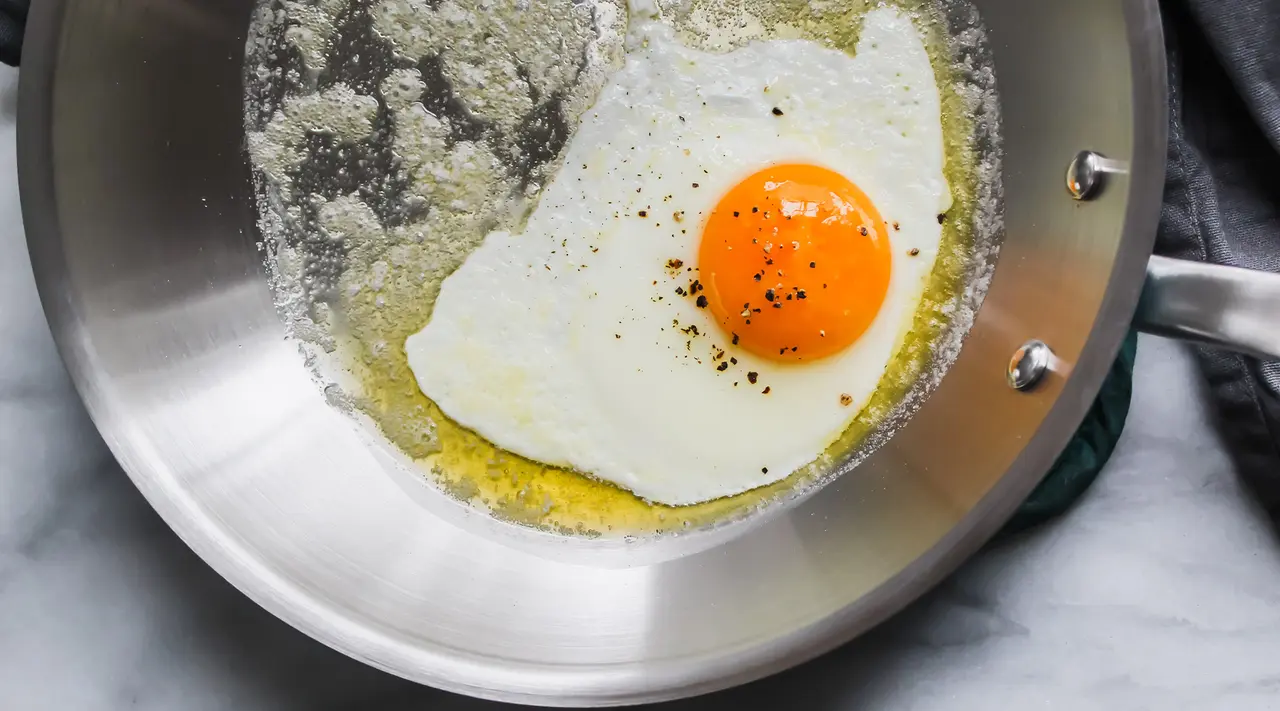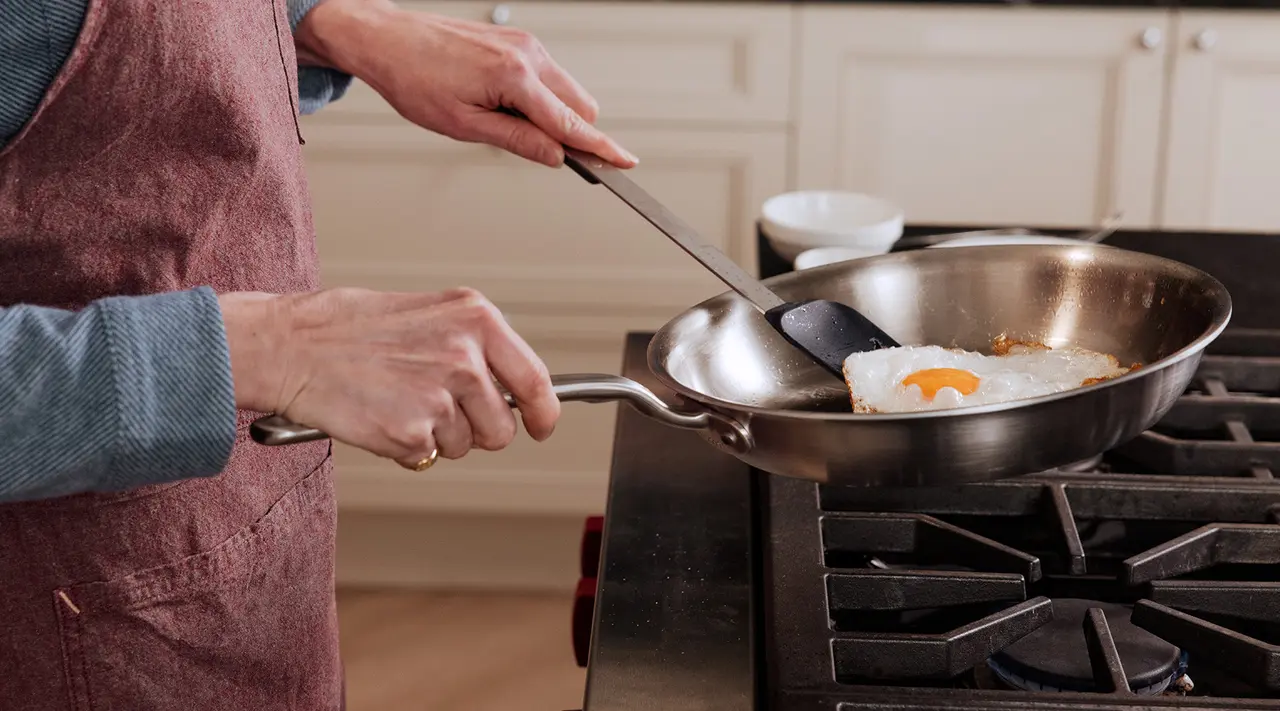If you’ve never done it before, cooking eggs on stainless steel can seem intimidating. No non stick coating to offer guaranteed success? No infomercial-like slide onto the plate that you’d see on ceramic? Not even the non stick coating insurance that comes from carbon steel or enameled cast iron?
But with a little homework (aka reading this blog post) and practice, you’ll soon find yourself reaching for a stainless steel skillet for all your egg cooking needs. Read on to learn how to cook eggs on stainless steel.
Why Would You Cook Eggs on Stainless Steel?

Stainless steel offers even heat distribution and retention, which is helpful for basically anything you cook, including eggs. Stainless steel pans are also incredibly durable, so even if the eggs do stick, you can easily clean and buff them back into their original shape.
When it comes to fried eggs, a stainless steel skillet will grant you lacy edges, a perfectly cooked white, and a jammy yolk. Just add toast for a perfect little breakfast.
How to Cook Eggs on Stainless Steel: Step-by-Step
We’re talking about the most versatile and glorious of cooked eggs in this guide—fried eggs—but we’ll briefly touch on scrambled eggs at the end. Follow these steps (in the video above or written below) to get the ideal sunny side up fried egg, with a medium-cooked, jammy yolk, opaque whites, and a beautiful golden brown crispiness around the edges.
Step 1: Preheat the Pan
First, the most important step to cooking eggs (or anything) on stainless steel is preheating. Preheating your skillet creates a thin layer of air between the skillet’s surface and whatever it’s about to come in contact with, making your food glide across the surface rather than stick to it.
Preheat the pan over medium-low heat for about 2 to 3 minutes, until the pan feels warm but isn’t blazing hot. This temperature will ensure the egg white cooks all the way but the yolk remains a little runny. (If you prefer your eggs with extra crispy edges, you can also preheat the pan over medium-high heat, then drop it down to medium-low once you add your egg.)
Step 2: Add Fat
Next, add your fat. We like to use a neutral, high-smoke point oil like grapeseed, but you can also use olive oil or butter. You’ll only need 1 tablespoon of fat; add the fat to the skillet, swirl it around to evenly coat the surface, and watch for the fat to shimmer across the pan. If it starts smoking, your pan is too hot; more on that below.
Step 3: Frying the Eggs
Finally, add the egg, then season with a little salt. After about 1 ½ minutes, the egg will start crisping around the edges. At this point, tilt the pan so the fat pools on one end, then use a spoon or spatula to baste the egg with the fat. This will help the top of the egg finish cooking.
Keep cooking until the white and yolk reaches your desired doneness. For set white and a slightly runny yolk, this will take about 1 to 2 more minutes. Slide the egg onto your plate, atop a slice of toast, or on a bed of chilaquiles. You did it.
Bonus: Scrambled Eggs
To make scrambled eggs, the process is very similar, but you’ll want to heat your pan over medium to medium-high heat, add your fat, then drop it down to medium-low once you add the eggs. Stir as infrequently or frequently as you’d like to achieve fluffy or smooth scrambled eggs, depending on your preference. You might run into slight sticking around the edges of the pan, but a brief soak in soapy water should loosen it up.
Troubleshooting Common Issues

This isn’t non stick cookware, which pretty much guarantees a well-cooked fried egg, so there are a few problem points you might run into as you learn how to cook eggs on stainless steel.
Sticking
The main cause of sticking on stainless steel is a lack of preheating. With proper preheating, a thin layer of air forms above the pan’s surface, which allows food to glide rather than stick.
Do the water test to determine if your pan is the correct temperature. If a small drop of water stays intact and rolls around on the surface before evaporating, you’re good to go. (That layer of air makes the water roll around like a marble.) If the pan is too cold, it’ll evaporate quickly; if it’s too hot, the water will fracture and scatter.
Another aspect to keep in mind is that the pan releases food when it’s done. If you try to flip your egg and it’s stuck to the surface, give it a bit before trying again. If you’re used to the ease and convenience of non stick, it may take a few tries to build your trust—so don’t get discouraged by one stuck egg.
If you run into sticking issues, don’t give up. Your pan isn’t ruined by any means—read our guide on restoring all manner of stainless steel messes—and with a little more practice, you’ll soon nail it.
Temperature Control
Our 5-ply construction makes for pans that heat quickly—perhaps more quickly than you’re used to with other brands of stainless steel cookware. As such, it is easy to burn or overcook something since the pan warms up so quickly.
If you add your fat and it immediately begins smoking, then your pan is too hot. Remove it from heat to cool down for a minute or two, then wipe the pan clean and start again.
Ready to Cook?
You might worry about food—especially eggs—sticking to stainless steel, but with a little practice, proper preheating, and a small amount of fat, you’ll soon see it’s easy to make eggs on stainless steel. Check out our selection of Stainless Clad Frying Pans and other cookware and you’ll be frying lacy, golden brown edged eggs in no time.































